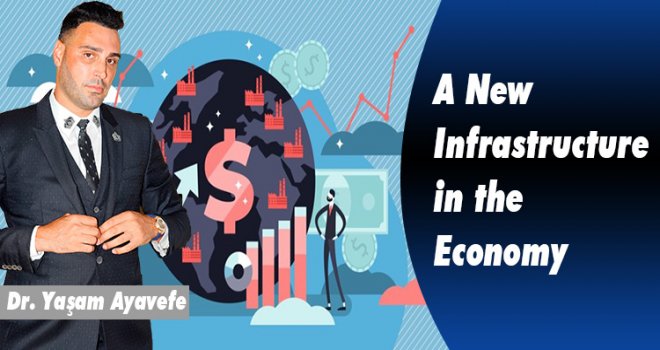

A New Infrastructure in the Economy
US government policy, industry ownership, and unique network features largely explain the rapid globalization of the Internet.

The Internet has become a universal medium that connects all economic units. Therefore, it is natural for more than one economic activity to settle there and electronic commerce to emerge.
However, the definition of this concept is unclear. Because, as measurement attempts have proven, its scope is circumstantial. There is a very restrictive meaning with a very broad meaning that includes all economic activities supported by networks. That is, it is limited to online transactions on the Internet.

Three basic observations should be made in this regard.
First, the development of economic activities on networks, including digital networks, began long before the Internet. In addition, it continues to spread in numerous media. These media will eventually converge on the Internet, but they remain different today.
Still, there is no need to go back to the telegram or the telephone, which play an important role in integrating a certain number of markets. We can note the emergence of large online transaction systems based on digital networks, especially in finance, air transport, since the 1970s.
The 1980s later saw the proliferation of different types of intercompany information integration systems, particularly in the trade, logistics and assembly industries such as the automotive or aerospace. All of these systems still exist today.
As for in-house telecomputing networks, the first one dates back to the 1960s.
E-commerce, both broadly and narrowly, does not proceed from the Internet alone. We now have some distance to analyze the role played by ICTs in the evolution of economic coordination.
One of the main consequences in this context is that technology by itself does not determine any optimal organizational model.
Certain constraints on organizational choices made by economic agents need to be removed. These choices basically depend on the way problems arise.
Depending on the activities and institutional frameworks, coordination emerges. For this reason, there are many tangible forms of electronic markets and hierarchies, as well as situations where electronic media seem to be of little use.
Second, the digitization of the economy is undeniable. When you read some growth forecasts, which were popularized by the press and even some official reports, the developments do not happen as you imagine.
It is very difficult to accurately and relevantly measure the share of activities powered by digital networks. In particular, we very often try to assess the weight of operations conducted entirely online.

However, daily observations have the same importance in all dimensions of social life as in commercial matters.
This shows that certain key components of the operation make it suitable for digitization and online production. Other components escape this virtualization.
Since the virtual is complementary and inseparable from the real, it is pointless to try to measure the economic weight of the purely virtual. It is hardly surprising that pure online weight appears to be marginal in the economy.
When this point of the method is achieved, a new step must be taken. It is necessary to modulate the digitization of the economy.
In the late 1990s, impressive growth rates were observed in many Internet-related fields. There has been improvement in both the size and activities of the network and the volume of economic transactions it supports.
Three factors came together to explain this very fast starting rate.
First, before 1995, the Internet was only a private network, limited to non-commercial applications. Therefore, the level was very low in the beginning.
It then contributed to sustaining artificial growth, as many services were offered at prices well below cost price. Finally, a certain number of services and activities have been transferred from specialized networks to the Internet.
The only truly reliable figures for e-commerce are data from the Ministry of Commerce. These data confirm the fact of a quick start. In the United States, online retail commerce has grown in volume since it was observed until the last quarter of 2000.
However, objectively observed growth levels and rates are much lower than predicted.
First of all, the first quarter of 2001 saw a decline in both the volume and relative weight of online commerce, whose share in retail trade fell to 0.91%.
Of course, these figures should not be seen as the beginning of the regression in the development of the internet and a move away from the digitization of the economy.
It just shows that some economic models developed during the speculative bubble are not valid, and that the pace of digitization of the economy is slow.
Because profound changes are required in many areas and it is necessary to move towards full digitalization. Because most of the consumption standard consists of tangible goods and services.
The resulting economic and technical constraints make it necessary to resort to traditional forms of organization of production and trade.
-
 Bugün yer yer sağanak bekleniyor… Önümüzdeki günlerde sıcaklık 31 dereceye kadar..
Bugün yer yer sağanak bekleniyor… Önümüzdeki günlerde sıcaklık 31 dereceye kadar..
-
 Milletin Partisi’nden YDP’ye İade-i ziyaret!
Milletin Partisi’nden YDP’ye İade-i ziyaret!
-
 Feyzioğlu: KKTC ve Kıbrıs Türklerinin güvenliği, uluslararası hukuka göre Türkiy..
Feyzioğlu: KKTC ve Kıbrıs Türklerinin güvenliği, uluslararası hukuka göre Türkiy..
-
 Dimitriu, Azerbaycan’a KKTC ile parlamentolar arası iş birliği niyeti yüzünden p..
Dimitriu, Azerbaycan’a KKTC ile parlamentolar arası iş birliği niyeti yüzünden p..
-
 Ege Denizi'nde 4,5 büyüklüğünde deprem
Ege Denizi'nde 4,5 büyüklüğünde deprem
-
 340 adet küçükbaş hayvan dağıtımı yapılacak
340 adet küçükbaş hayvan dağıtımı yapılacak
-
 Tatar: Kırılgan bir yapıya sahip bölgemizde en son isteyeceğimiz şey yeni bir sa..
Tatar: Kırılgan bir yapıya sahip bölgemizde en son isteyeceğimiz şey yeni bir sa..












